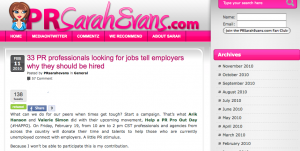Last week I was asked to speak at the annual MN PRSA Professional Practice Conference on blogger outreach–a topic I am passionate about. As many of you know, I almost exclusively use Prezi for my presentations now. And, given the way I use Prezi (relying on images and graphics over text and bullets), I thought instead of embedding the Prezi in a post that no one would understand, I’d tease out the presentation in a post.
My presentation last week focused on 11 best practices to building a more effective blogger outreach program. Why this particular approach? Because despite regular posts and articles about this topic, we’re not getting through to our PR colleagues. We continue to hear horror stories from bloggers–Danny Brown’s post last week is the prime example.
So, as an industry, we need to get better. We need to DO better. And start treating bloggers for what they are: Real people with real motivations and real communities.
Let’s start with these 11 best practices. Some of these I’ve touched on before–some are new. But, together they represent a pretty darn good starting point if you’re looking to get started in reaching out to bloggers.
 Cast the net. The first step in any blogger outreach program is identifying the right bloggers to target. Start not by using one single tool, but a mix that will give you the *best* possible list. I suggest using tools like Alltop, Technorati, Postrank, Klout and Google.
Cast the net. The first step in any blogger outreach program is identifying the right bloggers to target. Start not by using one single tool, but a mix that will give you the *best* possible list. I suggest using tools like Alltop, Technorati, Postrank, Klout and Google.
Don’t focus solely on the A-listers. Let’s say you were targeting PR bloggers. Folks like Brian Solis and Todd Defren would undoubtedly be considered A-listers in our space, right? Their blogs have massive readerships. They have huge followings on Twitter. But, does that mean they should always be on your list? How many pitches to you think those kind of folks get on a regular basis? How easy are they to get in touch with? On the flip side, what about bloggers at that next level down in terms of ranking–people like Heather Whaling and Shonali Burke. Both host weekly chats. Both are highly trusted among their peers. Sure, they might not have the *number* of eyeballs A-listers have–but they might have the *right* eyeballs for your client or organization.
 Don’t rely too much on the numbers. Let’s say you’re targeting two different bloggers and trying to decided between the two. Let’s keep with the folks I’ve mentioned above–I’ll pick on Brian Solis and Heather Whaling. On the surface, Brian has huge reach, tens of thousands of page views per month and a huge Klout score. Heather scores out fine–but nowhere near Brian (for the record, I’m picking on Heather here because she’s a good friend and I know she understands what I’m trying to do here).
Don’t rely too much on the numbers. Let’s say you’re targeting two different bloggers and trying to decided between the two. Let’s keep with the folks I’ve mentioned above–I’ll pick on Brian Solis and Heather Whaling. On the surface, Brian has huge reach, tens of thousands of page views per month and a huge Klout score. Heather scores out fine–but nowhere near Brian (for the record, I’m picking on Heather here because she’s a good friend and I know she understands what I’m trying to do here).
But, what the data doesn’t point out is that Heather leads the weekly #pr20chat which has a very engaged community. She’s a local #happo champion. And, she’s a regular contributor to the PR Breakfast Club. All provide a more well-rounded picture of who Heather is as a blogger than these numbers, right? My point: The numbers often don’t tell the whole picture with individual bloggers.
 Start a relationship. Spend at least 3-4 weeks getting to know the blogger. Follow their Twitter stream. Read their About page on their blog. Research the blogger on LinkedIn. Heck, many bloggers have “How to Pitch Me” sections on their blogs (Jason Falls and Dave Fleet in our industry)–you might want to make sure you read those, too. Bigger point: You can learn a whole heck of a lot by following along with a blogger for a few weeks–useful information you can use in your “pitch” later on.
Start a relationship. Spend at least 3-4 weeks getting to know the blogger. Follow their Twitter stream. Read their About page on their blog. Research the blogger on LinkedIn. Heck, many bloggers have “How to Pitch Me” sections on their blogs (Jason Falls and Dave Fleet in our industry)–you might want to make sure you read those, too. Bigger point: You can learn a whole heck of a lot by following along with a blogger for a few weeks–useful information you can use in your “pitch” later on.
 Don’t forget about offline activities. Inherently, bloggers are publishers at heart. So, chances are, they might be involved in other “offline” activities that may prove beneficial to your client. For example, I’m currently working with one blogger who just started a new magazine in her specific niche. What a great additional outlet for her to think about as we talk about her involvement with my client’s brand.
Don’t forget about offline activities. Inherently, bloggers are publishers at heart. So, chances are, they might be involved in other “offline” activities that may prove beneficial to your client. For example, I’m currently working with one blogger who just started a new magazine in her specific niche. What a great additional outlet for her to think about as we talk about her involvement with my client’s brand.
Get personal. Take all that information you learn in the “start a relationship” phase and put it to good use here. One of the best pitches I’ve received was from the Social Media Club. In the first paragraph they demonstrated they knew the topics I wrote about and mentioned my family. With all the bad pitches out there, a little personalization can help you cut right through the clutter.
Make your ask compelling and relevant. Whatever you do, don’t sent a blogger a press release. Speaking as a blogger, I don’t care about your press release. But, I might care about your brand, product or service. Treat me like a person, and I’m much more apt to engage. So, what should the “ask” look like? Give bloggers access to your brand. What about a behind-the-scenes tour at your manufacturing plant? What about building a blogger-only focus group to help design your next product? Give bloggers “behind the ropes” access and let them share their experiences.
Lead with them–not you. This is one that seems to get missed the most. Sure I might be a fan of your brand. But, I don’t care that much. The first paragraph of your pitch should be all about the blogger. A post they recently wrote that you liked. A trip they recently took. The fact that they were up half the night on Twitter. Whatever the case, lead with the blogger. Not with your brand.
 Collaborate–don’t preach. Whatever you do, don’t ASK the blogger to write about your brand. Sure, that’s what you want. They know that. You know that. Just give them access to your brand and let them do the rest. I think back to our original outreach as part of the HAPPO movement earlier this year. We didn’t tell our PR blogger colleagues what to write–we simply asked them to join us (this was Sarah Evans’ post about HAPPO earlier this year). Big difference.
Collaborate–don’t preach. Whatever you do, don’t ASK the blogger to write about your brand. Sure, that’s what you want. They know that. You know that. Just give them access to your brand and let them do the rest. I think back to our original outreach as part of the HAPPO movement earlier this year. We didn’t tell our PR blogger colleagues what to write–we simply asked them to join us (this was Sarah Evans’ post about HAPPO earlier this year). Big difference.
Identify the right metrics. There are so many metrics to consider when defining success of a blogger outreach campaign. Number of posts. Number of comments. Number of links back to your site. You can even measure leads in some cases (give the blogger a form that includes a “how did you hear about us?” question). The important part is to identify the right metrics up front. Don’t forget that important step.
The follow-up ask. You’ve done your research. You’ve made your ask. The blogger is interested. She wrote the post. Success! But, don’t stop there–look for ways to keep the blogger engaged with your brand. Are they someone you could ask to be a spokesperson for your brand? Wouldn’t that blogger be a great third-party, credible voice for that interview next week? Or, what about a guest post on your blog? Look for ways to keep them involved and give them opportunities to keep talking about your brand.
Other best practices you would share?

0 Comments